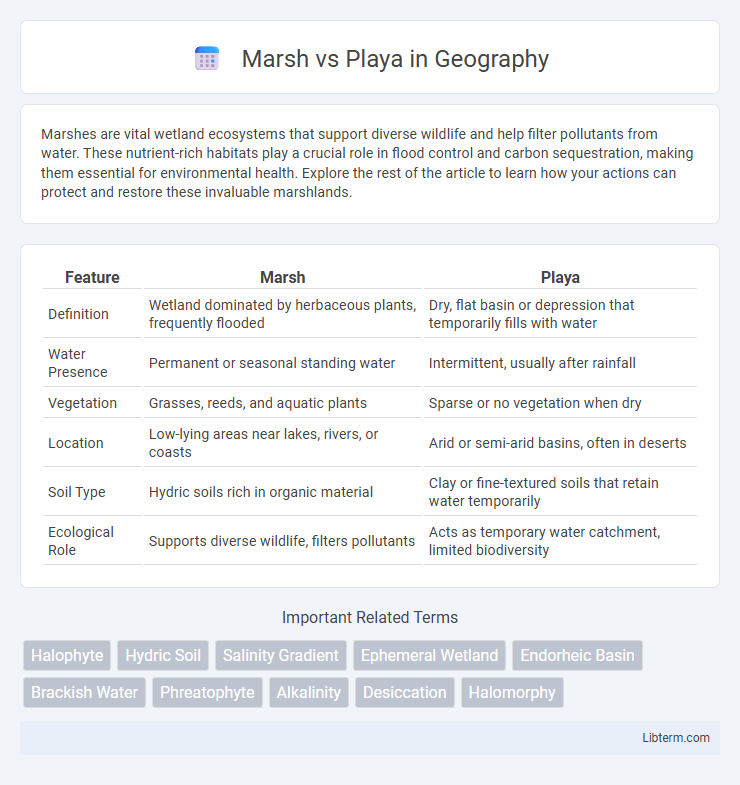Marshes are vital wetland ecosystems that support diverse wildlife and help filter pollutants from water. These nutrient-rich habitats play a crucial role in flood control and carbon sequestration, making them essential for environmental health. Explore the rest of the article to learn how your actions can protect and restore these invaluable marshlands.
Table of Comparison
| Feature | Marsh | Playa |
|---|---|---|
| Definition | Wetland dominated by herbaceous plants, frequently flooded | Dry, flat basin or depression that temporarily fills with water |
| Water Presence | Permanent or seasonal standing water | Intermittent, usually after rainfall |
| Vegetation | Grasses, reeds, and aquatic plants | Sparse or no vegetation when dry |
| Location | Low-lying areas near lakes, rivers, or coasts | Arid or semi-arid basins, often in deserts |
| Soil Type | Hydric soils rich in organic material | Clay or fine-textured soils that retain water temporarily |
| Ecological Role | Supports diverse wildlife, filters pollutants | Acts as temporary water catchment, limited biodiversity |
Overview: Marsh vs Playa
Marshes are wetlands characterized by herbaceous plants and often saturated soils, typically found in low-lying areas with slow-moving or stagnant water. Playas are ephemeral, flat-bottomed desert basins that temporarily fill with water after rainfall, exhibiting high salinity and mineral deposits due to rapid evaporation. Both marshes and playas provide critical habitats but differ significantly in hydrology, vegetation, and ecological functions.
Definitions and Key Differences
Marshes are wetland ecosystems characterized by saturated soils and abundant herbaceous plants like cattails and reeds, often found along riverbanks or coasts. Playas are shallow, ephemeral desert lakes or basins that periodically fill with water, typically found in arid regions and characterized by high salinity and clay-rich soils. The key differences lie in their hydrology, vegetation, and environmental settings, with marshes supporting continuous aquatic vegetation in permanently or seasonally wet conditions and playas functioning as temporary water bodies with minimal or no vegetation.
Formation Processes
Marshes form through the gradual accumulation of organic material and sediment in low-lying coastal or inland areas where water saturation supports dense vegetation growth, primarily grasses and reeds. In contrast, playas develop in arid or semi-arid regions as temporary, shallow basins where evaporation exceeds precipitation, leading to the deposition of fine sediments and evaporite minerals like gypsum and halite. The formation of marshes is fundamentally driven by biotic activity and hydrological stability, whereas playas are shaped by climatic variability and episodic water inputs.
Geographic Distribution
Marsh ecosystems predominantly occur along coastal regions and estuarine environments where saltwater and freshwater mix, supporting diverse flora and fauna adapted to brackish conditions. Playa lakes are typically found in arid and semi-arid interior basins, such as the southwestern United States, characterized by ephemeral water bodies that briefly fill during seasonal rains. The geographic distribution highlights marshes as coastal, wet landscapes contrasting with playas' inland, dry basin settings.
Hydrology and Water Sources
Marsh ecosystems are characterized by saturated soils and standing water, primarily fed by surface water and groundwater inputs, which create a stable hydrological environment essential for diverse wetland flora and fauna. Playa lakes, in contrast, are ephemeral basins that fill intermittently with precipitation or runoff, relying heavily on episodic rainfall and limited groundwater recharge, resulting in highly variable water availability. The hydrology of marshes supports continuous water presence, while playas exhibit rapid drying cycles influenced by regional climate and soil permeability.
Soil and Sediment Characteristics
Marsh soils are typically rich in organic matter, characterized by saturated, anoxic conditions that promote peat accumulation and nutrient retention, creating a unique substrate for diverse wetland vegetation. Playa sediments are primarily composed of fine-grained clays and silts, with periodic evaporite minerals due to intermittent flooding and evaporation cycles, resulting in alkaline, saline soils. These contrasting soil and sediment properties influence hydrology, chemical processes, and ecological functions in marsh and playa environments.
Vegetation and Biodiversity
Marshes are wetlands dominated by herbaceous plants such as reeds, cattails, and sedges, supporting high biodiversity with abundant bird, fish, and invertebrate species. Playas, on the other hand, are ephemeral, shallow, flat-bottomed basins found in arid regions, where vegetation is sparse and mainly consists of halophytes and drought-tolerant annuals. The biodiversity in playas is lower compared to marshes but plays a crucial ecological role during wet periods by providing habitat for migratory birds and specialized aquatic organisms.
Ecological Functions and Services
Marshes provide critical ecological functions, including water filtration, flood mitigation, and habitat for diverse wildlife species, thereby sustaining biodiversity and improving water quality in coastal and inland ecosystems. Playa lakes, although ephemeral, serve as important stopover sites for migratory birds and contribute to groundwater recharge during wet periods. Both ecosystems play essential roles in carbon sequestration and nutrient cycling, supporting overall ecosystem resilience and stability.
Human Impacts and Conservation
Human impacts on marsh and playa ecosystems include urban development, agriculture, and pollution, leading to habitat loss and water quality degradation. Conservation efforts prioritize restoring natural hydrology, controlling invasive species, and implementing protective regulations to preserve biodiversity and ecosystem services. Effective management requires integrating scientific research with community engagement to enhance resilience against climate change and human pressures.
Comparative Summary: Marsh vs Playa
Marshes are wetlands characterized by perennial or seasonal standing water with emergent grasses, sedges, and herbaceous plants, providing crucial habitats for diverse wildlife. Playas are ephemeral, shallow, and predominantly dry basins found mostly in arid regions, accumulating water only after heavy rainfall and supporting salt-tolerant vegetation. While marshes maintain more consistent hydrology and nutrient cycling, playas contribute to groundwater recharge and host unique flora adapted to saline, transient conditions.
Marsh Infographic

 libterm.com
libterm.com